
Markov Processes and Related Fields
Scope & Guideline
Empowering Scholars with Critical Statistical Insights
Introduction
Aims and Scopes
- Markov Processes and Stochastic Models:
The journal publishes research on various types of Markov processes, including continuous-time and discrete-time models, highlighting their mathematical properties, convergence behaviors, and applications in diverse fields such as physics, biology, and finance. - Statistical Mechanics and Critical Phenomena:
Research on the connection between stochastic processes and statistical mechanics is a core focus, particularly in the context of phase transitions, critical behavior, and the dynamics of interacting particle systems. - Network Theory and Complex Systems:
The journal often explores models related to complex networks, including epidemic models on networks and percolation theory, which are crucial for understanding phenomena in social, biological, and technological networks. - Applications in Epidemiology and Population Dynamics:
There is a significant emphasis on modeling infectious diseases and population dynamics through branching processes and other stochastic frameworks, reflecting the journal's relevance to public health and environmental studies. - Mathematical Methods and Theoretical Frameworks:
Contributions include the development of new mathematical techniques and theoretical results that enhance the understanding of Markov processes, stochastic calculus, and related probabilistic structures.
Trending and Emerging
- Active Matter and Non-Equilibrium Systems:
There is a growing body of work focused on active matter, which involves systems of self-propelled particles and their collective behaviors. This theme connects physics, biology, and engineering, highlighting the importance of non-equilibrium dynamics. - Complex Network Dynamics:
Research on complex networks, particularly in relation to epidemic modeling and optimization problems, is on the rise, reflecting an increasing interest in understanding how network structure influences system behavior and resilience. - Stochastic Differential Equations and SPDEs:
The application of stochastic differential equations (SDEs) and stochastic partial differential equations (SPDEs) is gaining traction, with researchers exploring new methods and applications in various fields, including finance and physics. - Branching Processes and Population Models:
There is an emerging focus on branching processes as a tool for modeling population dynamics and infectious diseases, reflecting the practical need for robust models in epidemiology and ecology. - Interdisciplinary Applications and Collaborations:
An increase in publications that bridge Markov processes with fields like bioinformatics, statistical mechanics, and machine learning indicates a trend towards interdisciplinary research that leverages probabilistic methods to address complex problems.
Declining or Waning
- Traditional Queueing Theory:
Although queueing theory remains important, there has been a noticeable decrease in publications focusing on classical queueing models, possibly due to the growing interest in more complex and dynamic systems that better reflect real-world scenarios. - Basic Random Walk Models:
The foundational studies on random walks, particularly those that do not incorporate additional complexities or real-world applications, appear to be declining, as researchers increasingly seek to apply random walk theories to more intricate systems. - Static Models in Stochastic Analysis:
Research focusing solely on static models without considering dynamic or adaptive elements seems to be less prevalent, indicating a shift towards more dynamic modeling approaches that capture temporal changes in systems. - Homogeneous Models in Complex Systems:
There is a waning interest in purely homogeneous models, as the field moves towards investigating heterogeneous and multi-scale systems that better represent the diversity seen in real-world applications.
Similar Journals

THEORY IN BIOSCIENCES
Advancing Theoretical Insights in BiosciencesTHEORY IN BIOSCIENCES, published by SPRINGER, is a prominent academic journal in the interdisciplinary fields of Applied Mathematics, Ecology, and Statistics. With an ISSN of 1431-7613 and an E-ISSN of 1611-7530, this journal is accessible to a global audience and facilitates Open Access options, ensuring that cutting-edge research reaches its intended audience promptly. Established in 1997 and set to converge into 2024, THEORY IN BIOSCIENCES holds a pivotal role in advancing theoretical and methodological approaches in biosciences, evidenced by its respectable placement in the Q3 quartile within the 2023 category rankings. Its Scopus rankings reflect a growing reputation, particularly in Mathematics and Ecology, making it an essential resource for researchers and professionals seeking to enhance their understanding of complex biological systems and data analysis techniques. Positioned in Germany and powered by SPRINGER's esteemed publishing standards, the journal is dedicated to fostering scholarly communication, offering a platform for innovative research that bridges theoretical frameworks and practical applications.

ELECTRONIC JOURNAL OF PROBABILITY
Fostering Innovation Through Accessible ResearchThe Electronic Journal of Probability, published by the Institute of Mathematical Statistics (IMS), is a premier open access journal dedicated to the dissemination of innovative research in the field of probability theory. Since its inception in 1996, it has emerged as a leading platform for scholars, researchers, and practitioners to share their findings and explore new methodologies. With an impressive track record and a commitment to free accessibility, the journal covers a broad scope of topics within statistics and probability, validated by its prestigious rankings in the Q1 quartile for both Statistics and Probability. Its influence is further evidenced by its consistent presence in the academic community and its contribution to advancing understanding in probability and uncertainty. The journal's ongoing dedication to promoting open scholarship ensures that high-quality research remains accessible to all, fostering collaboration and innovation among professionals and students alike.
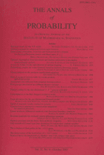
ANNALS OF PROBABILITY
Unveiling the Power of Probabilistic MethodsANNALS OF PROBABILITY, published by the Institute of Mathematical Statistics (IMS), is a premier academic journal dedicated to the field of probability theory and its applications. With an impressive impact factor and ranked within the top quartile (Q1) in both Statistics and Probability and Statistics, Probability and Uncertainty categories as of 2023, this journal serves as a vital platform for researchers and practitioners in the field. The journal has a significant convergence period from 1996 to 2024, reflecting its enduring contribution to the scientific dialogue surrounding probabilistic methods and theory. The journal garners a high standing in Scopus rankings, holding a remarkable 35th position out of 278 in Mathematics and boasting an 87th percentile ranking, underscoring its influence and reach. While it does not provide Open Access options, its rigorous peer-review process ensures the publication of high-quality research that advances the understanding and application of probability across various disciplines. Researchers, professionals, and students alike will find the ANNALS OF PROBABILITY instrumental in their academic pursuits and professional development in the evolving landscape of probability and statistics.
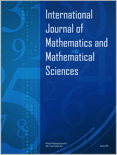
INTERNATIONAL JOURNAL OF MATHEMATICS AND MATHEMATICAL SCIENCES
Advancing mathematical frontiers since 1978.INTERNATIONAL JOURNAL OF MATHEMATICS AND MATHEMATICAL SCIENCES is a distinguished peer-reviewed journal published by HINDAWI LTD, dedicated to advancing the field of mathematics and its various applications. Since its inception in 1978, the journal has been committed to open access, ensuring that research is freely available to all, thereby fostering greater collaboration and dissemination of knowledge. With an impressive Q3 ranking in the Mathematics (miscellaneous) category and a notable Scopus rank in the 72nd percentile, this journal is a vital resource for researchers, professionals, and students. The journal covers a wide range of topics in mathematics, from theoretical explorations to applied methodologies, and it continues to serve as a platform for significant contributions in this evolving discipline. Its continuous publication from 1978 to present reflects its enduring relevance and impact in the mathematical sciences community.

Probability and Mathematical Statistics-Poland
Bridging Disciplines Through Statistical ExcellenceProbability and Mathematical Statistics-Poland is a pivotal journal in the field of applied and theoretical statistics, published by WYDAWNICTWO UNIWERSYTETU WROCLAWSKIEGO. With an ISSN of 0208-4147, it serves as a platform for disseminating significant research grounded in mathematical statistics, probabilistic models, and their applications across various scientific disciplines. Although the journal resides in the Q4 category for Statistics and Probability, it plays an essential role for researchers seeking a peer-reviewed avenue for their work, particularly those affiliated with academic institutions in Poland and beyond. The journal has been in continuous publication from 2011 to 2023, reflecting its commitment to advancing knowledge in the field despite its current ranking at the 12th percentile in the Scopus listings. As an invaluable resource for researchers, professionals, and students alike, Probability and Mathematical Statistics-Poland encourages contributions that explore innovative statistical methodologies and their practical implications, fostering a deeper understanding of probability theory and its relevance in contemporary research.
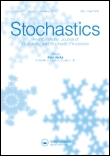
Stochastics-An International Journal of Probability and Stochastic Processes
Connecting Scholars Through Groundbreaking Stochastic InsightsStochastics: An International Journal of Probability and Stochastic Processes, published by Taylor & Francis Ltd, is a pivotal platform for the dissemination of innovative research in the realms of probability and stochastic processes. Since its inception in 1975, the journal has evolved to encapsulate a rich array of methodologies and applications, contributing significantly to the fields of modeling, simulation, and statistical analysis. With a current impact factor ranking in the Q3 category for both Modeling and Simulation and Statistics and Probability, it positions itself as a valuable resource for professionals, researchers, and students alike. The journal’s coverage spans a unique historical arc from 1975, and it continues to push boundaries up to 2024, ensuring the latest trends and discoveries are accessible to an engaged audience. Though not Open Access, the journal’s scholarly contributions are crucial for advancing understanding and innovation in stochastic modeling, making it an essential read for those seeking to deepen their expertise in the field.
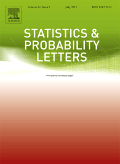
STATISTICS & PROBABILITY LETTERS
Connecting theory and application in the world of probability.STATISTICS & PROBABILITY LETTERS is a distinguished journal published by ELSEVIER, dedicated to advancing the field of statistics and probability. With an ISSN of 0167-7152 and an E-ISSN of 1879-2103, this journal is an essential platform for research, featuring cutting-edge studies and significant findings in the realms of statistical theory and applied probability. The journal operates under a notable Q3 ranking in both the categories of Statistics and Probability, and Statistics, Probability and Uncertainty for 2023, underscoring its relevance in these fields. Researchers, professionals, and students alike benefit from its rigorous peer-review process and its commitment to published integrity, fostering innovative insights from 1982 through its anticipated convergence in 2025. While it does not offer open access, the journal’s widely recognized impact within the academic community makes it a valuable resource for anyone seeking to deepen their understanding of statistical methodologies and probabilistic models.
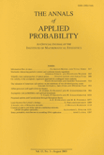
ANNALS OF APPLIED PROBABILITY
Unveiling the Power of Probability in Diverse FieldsANNALS OF APPLIED PROBABILITY is a prestigious journal dedicated to advancing the field of applied probability, providing a platform for rigorous research and innovative applications. Published by the Institute of Mathematical Statistics (IMS), this journal has earned a reputable standing in the academic community, reflected in its 2023 ranking as Q1 in both Statistics and Probability and Statistics, Probability and Uncertainty. With a focus on disseminating high-quality articles, it plays a critical role in bridging theoretical advancements and practical applications in various domains of probability. The journal features a robust editorial process and attracts contributions from leading researchers, fostering a vibrant discourse essential for academic and professional development. Researchers and practitioners seeking to deepen their knowledge and stimulate intellectual growth will find the ANNALS OF APPLIED PROBABILITY an invaluable resource, with its significance exemplified by its Scopus rankings that showcase its influence within the statistics community.

COMMUNICATIONS ON PURE AND APPLIED MATHEMATICS
Exploring the Depths of Mathematical InnovationCommunications on Pure and Applied Mathematics, published by Wiley, is a prestigious journal in the field of mathematics, recognized for its rigorous exploration of both theoretical and applied mathematical concepts. With an ISSN of 0010-3640 and an E-ISSN of 1097-0312, this journal has been a cornerstone of mathematical research since its inception in 1948 and will continue to serve the academic community until 2024. Ranked in the Q1 category for both Applied Mathematics and Miscellaneous Mathematics in 2023, it holds a commendable position among its peers, as evidenced by its Scopus rankings—#9 out of 399 for General Mathematics, placing it in the 97th percentile, and #55 out of 635 for Applied Mathematics, at the 91st percentile. The journal promotes the dissemination of high-quality research and fosters advancements in the mathematical sciences, making it an invaluable resource for researchers, professionals, and students alike, who are eager to stay at the forefront of mathematical innovation and application.

INFINITE DIMENSIONAL ANALYSIS QUANTUM PROBABILITY AND RELATED TOPICS
Transforming Complex Theories into Practical ApplicationsINFINITE DIMENSIONAL ANALYSIS QUANTUM PROBABILITY AND RELATED TOPICS, published by WORLD SCIENTIFIC PUBL CO PTE LTD, is a key academic journal dedicated to the exploration of advanced themes in applied mathematics, mathematical physics, and quantum probability. Since its inception in 1998, the journal has established itself as a critical resource for researchers and professionals in these interdisciplinary fields, currently standing in the third quartile according to the 2023 category rankings. Scholars can access a wealth of rigorous articles that delve into infinite dimensional analysis, providing valuable insights pertinent to statistical and nonlinear physics, and offering a platform for pioneering research. This journal not only bridges theoretical frameworks and practical applications but also nurtures a collaborative environment for emerging and established scholars. Through its commitment to advancing knowledge, INFINITE DIMENSIONAL ANALYSIS QUANTUM PROBABILITY AND RELATED TOPICS serves as an indispensable tool for anyone engaged in the forefront of quantum probability research.